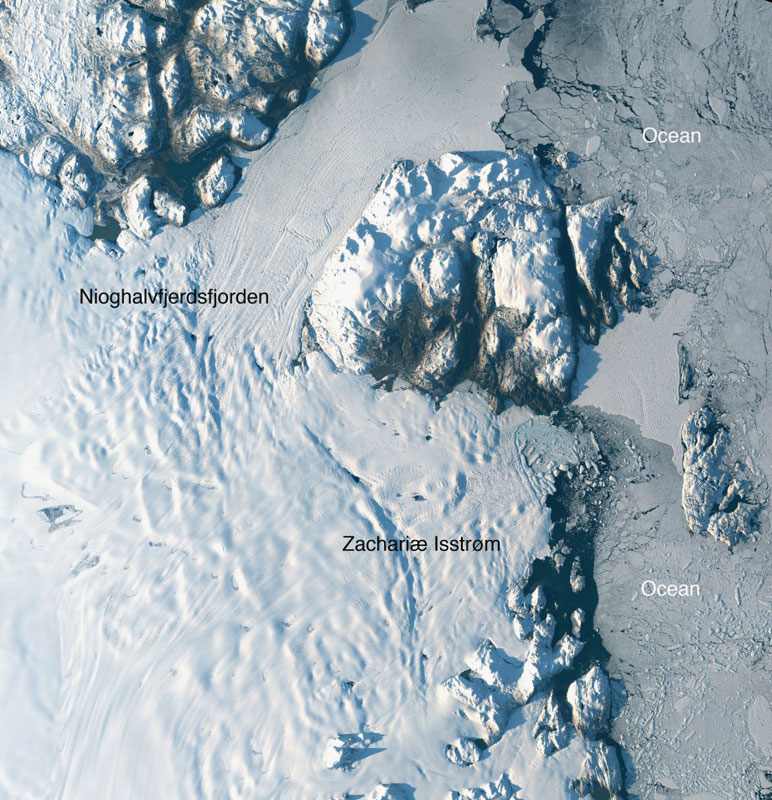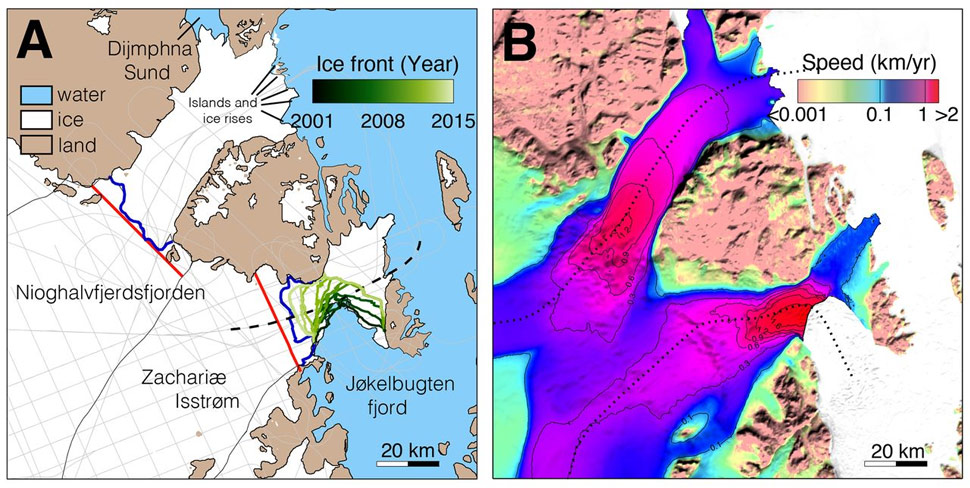
14th November 2015 Massive Greenland glacier is melting rapidly The huge Zachariae Isstrom glacier in northeast Greenland, which holds enough ice to raise global sea levels by half a metre, is reported to be melting and crumbling into the North Atlantic Ocean.
A glacier in northeast Greenland that holds enough water to raise global sea levels by over 0.5 metres has come unmoored from a stabilising sill and is crumbling into the North Atlantic Ocean. Losing mass at a rate of 5 billion tons per year, the glacier Zachariae Isstrom entered a phase of accelerated retreat in 2012, according to findings published this week in the journal Science. "North Greenland glaciers are changing rapidly," said lead author Jeremie Mouginot, a project scientist at the University of California, Irvine. "The shape and dynamics of Zachariae Isstrom have changed dramatically over the last few years. The glacier is now breaking up and calving high volumes of icebergs into the ocean, which will result in rising sea levels for decades to come." The research team – including scientists from NASA's Jet Propulsion Laboratory and the University of Kansas – used 40 years of data from aerial surveys by NASA's Operation IceBridge and satellite-based observations by multiple international space agencies (NASA, ESA, CSA, DLR, JAXA and ASI) coordinated by the Polar Space Task Group. The highly sensitive radar sounder, gravimeter and laser profiling systems, coupled with radar and optical images from space, monitor and record changes in the shape, size and position of glacial ice over long time periods, providing precise data on the state of Earth's polar regions. "For the first 25 years, the glacier was stable," Mouginot says. From 2000 to 2012, however, it began to move more rapidly; and each year since 2012 it has tripled in speed. The leading edge where ice meets the ocean is now melting at a rate of two kilometres per year. There is "huge potential" for increasing the rate of global sea level rise in future decades, as it continues to flow into the warmer ocean, Mouginot notes. "Even if we have some really cool years ahead, we think the glacier is now unstable," he says.
The scientists found that the bottom of Zachariae Isstrom is being rapidly eroded by warmer ocean water, combined with growing amounts of meltwater from the ice sheet surface: "Zachariae Isstrom is being hit from above and below," said senior author Eric Rignot, Chancellor's Professor of Earth system science at UCI. "The top of the glacier is melting away as a result of decades of steadily increasing air temperatures, while its underside is compromised by currents carrying warmer ocean water, and the glacier is now breaking away into bits and pieces and retreating into deeper ground." Zachariae Isstrom neighbours another large glacier to the north – this one named Nioghalvfjerdsfjorden – that is also melting rapidly, but is receding at a slower rate because it's protected by an inland hill. Combined, the two glaciers make up 12 percent of the Greenland ice sheet and would boost global sea levels by over a metre (39") if they fully collapsed. The entire Greenland ice sheet holds enough water to raise global sea levels by seven metres. "Not long ago, we wondered about the effect on sea levels if Earth's major glaciers were to start retreating," Rignot noted. "We no longer need to wonder; for a couple of decades now, we've been able to directly observe the results of climate warming on polar glaciers. The changes are staggering and are now affecting the four corners of Greenland." This week, the UK Met Office announced that global average temperatures for 2015 are likely to exceed 1°C above the pre-industrial baseline (if using 1961-1990 as the baseline, this point is likely to be reached by the early 2020s). That may sound like a small rise, but for an object the size of the Earth it's a vast amount of heat energy: roughly equivalent to four Hiroshima bombs every second of every day. The Arctic region including Greenland is warming twice as fast as the rest of the world. This year, NASA began a new six-year field campaign, the aptly-named OMG (Oceans Melting Greenland), which aims to study ocean conditions around Greenland affecting the Ice Sheet.
Comments »
|








